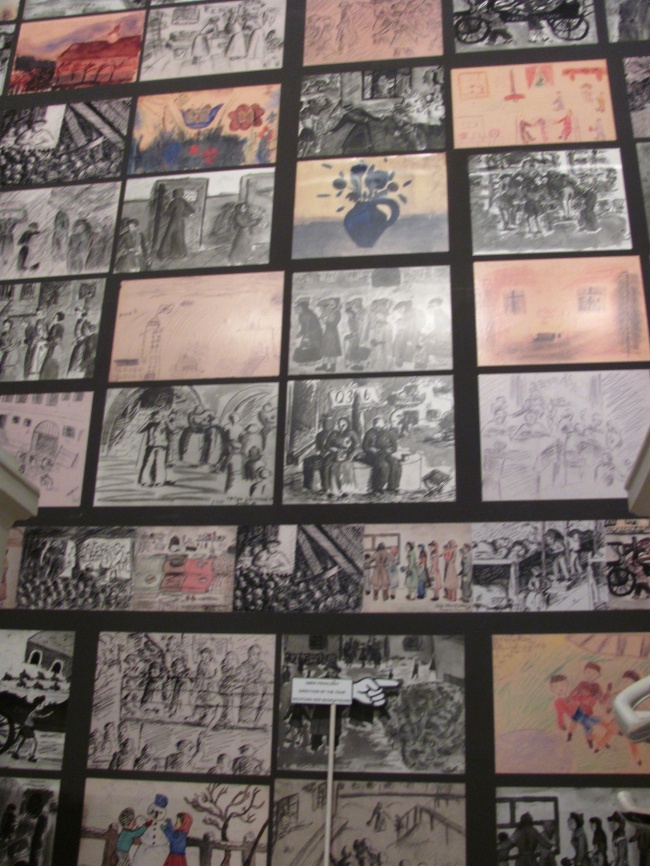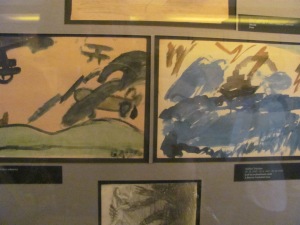You are currently browsing the monthly archive for April 2014.
Krakow, Poland is one of the most beautiful cities I have ever been to. Today steph and I will take a walk through the many parts of the city eating kilebasa, smoked cheese and stuffed cabbage in the old Jewish section of Kazimierz, but yesterday….
we spent the day in silence as we toured the site of one of humanity’s most unspeakably horrifying tragedies a hour and a half away; The site where the Nazi’s murdered 1,100,000 people; Auschwitz-Birkenau.
It is a person’s duty after visiting this site to tell the world what happened here. So for readers that have not made this visit, I know this may not be easy but I ask you, in honor of the victims and genocide awareness month, to read on or look up your own information on this and other Nazi extermination camps.
Jews were not the only victims of the Nazi’s plan to rid the world of “undesirables”, homosexuals, disabled, gypsies and resistors to the regime were among the victims of their extermination plan.
Auschwitz is broken into three camp areas. We first visited Auschwitz I.
To enter you must walk under the iron sign bearing the phrase “Arbeit Macht Frei”, “work sets you free”. An ironic message as the only way to gain freedom in the camps was through the chimneys of the crematoriums. Prisoners selected to weld the sign, in a small act of defiance, placed the ‘B” upside-down.
There was nothing more surreal than standing on the dirt path next to the train tracks that were the arrival site of Jews at their final destination at Birkenau. I had seen the picture of the guard tower dozens of times and learned about it my entire life but to be there hit me deep in my soul.
I felt the fingertips of my daughter reach out and grab for mine. I felt her compassionate hand throughout the rest of the tour on my back. At Auschwitz II, prisoners were separated upon arrival, mothers from their children, husbands from wives. The strong would go to Auschwitz I and live for approximately 2 months until the work, torture or starvation killed them. The others, less strong children, women, disabled would go directly to the gas chambers. To avoid panic, the Nazi’s told their victims to remember where they had hung their clothes so they could retrieve them afterwards.
Shoes left behind by victims who entered gas chambers
At Auschwitz I camp we toured the barracks where prisoners were crammed in groups to sleep on wooden slats, the execution wall where those who committed crimes such as stealing some bread were shot and starvation cells for prisoners and those who tried to escape. We learned about everyday life; 12 hours of severe work conditions with a dish of liquid food and without proper clothes. twenty percent 20% of the victims in the prison were children. We saw how the people went from deported to dehumanized, each step of the way reducing them from a person to an object with a number thus making it possible for SS soldiers to carry out their “final Solution”. Prisoners also carried out acts such as removing teeth and hair from bodies after the gassing and shoveling excrement. In fact, taking one of these jobs was possibly the only way to survive in the camps.
After the Nazis realized that Auschwitz I was not big enough to handle the amount of prisoners or the amount of killings they needed to achieve in an hour (4,500 deaths in 3 hours was not sufficient speed), they built Auschwitz II, a more efficient death camp.
Entrance to gas chamber at Auschwitz II
Birkenau made Auschwitz I look like a 3 star hotel. The Nazi’s plan was to grow Birkenua to an even larger capacity as it ws still under construction and expansion in 1945 during the liberation of the camp.
Steph and I returned to Krakow in silence. As we started to speak about what we experienced and how we felt, We asked each other so many unanswerable questions. What brings a human being to follow such commands and act so monstrously? How is it possible to survive the conditions we witnessed even for a short time? We both agreed we could not have been strong enough. What does it mean to say “never again’? Isn’t it the responsibility of nations to protect civilians from human rights abuses? Isn’t that what the world was supposed to have learned? Isn’t that the purpose of the memorials we see, the films we watch, the books we read? Does “never again” only have meaning for a white person, a European, a Jew? Why do we know that monsters who kill innocent people for power and resources still carry out their operations as we speak? We cannot forget those who suffer in displaced persons camps around the world today, those who have been taken into lives of slavery and abuse or who suffer at the hands of violence, discrimination and monstrous leaders. The only way to make “never again” a reality is to coninue to speak about the abuses we see.
Today I heard that my friend and Carl Wilkens Fellow, Mealnie Nelkin, will be receiving The Humanitarian Award by the Georgia Commission on the Holocaust. This award is given to individuals or groups that have “demonstrated the spirit of humanity through volunteer work, advocacy, leadership and/or philanthropy in their community, thereby fighting indifference, intolerance and injustice.” Melanie has ben an advocate for genocide prevention for years. A nonstoppable force in Washingon DC and an inspiration to many. I dedicate this post to her for her continued commitment to genocide prevention.
Our Journey took us one hour from the center of Prague to Terezin, the concentration work camp and ghetto.
Terezin was originally a fortress prison established in the late 18th century as a prison for military and political convicts. In 1941 it was used by the Nazi’s as a prison for Jews. Jews that were brought to Terezin from Prague, some 83,000, with the exception of a handful of survivors, were never seen again.
They were all deported to extermination camps in the East.
What is most poignant about visiting Terezin is not the cold stone cells, cramped ghetto barracks or crematorium, all chillingly horrifying but the multitude of artists, composers, musicians, writers and actors that left behind the real, untold story of Terezin. You see, the Nazi’s wanted the world to think they had set up a beautiful home for the Jews at Terezin and they knew they had captured some of Prague’s most talented people in the small space of the ghetto to tell that false story. As part of their grand scheme, the Nazi’s used this talent to create drawings and films, poems and songs of propaganda.
Viewing the films and paintings created under Nazi instruction, one would think that life was wonderful in Terezin. Jewish soccer matches, knitting clubs, art exhibits, plays and operas were occurring at all times. What was really going on here was beyond the brain’s capability to comprehend.
Bedrich Fritta, Leo Hass, Otto Unger, Karel Fleischmann, Peter Klein….. Do these names ring a bell? Probably not like Pablo Picasso, Vincent Van Gogh, and Henri Matisse do, because these Terezin artists were exterminated along with their families by the Nazi’s long before they reached the age of 25.
Terezin artists were given materials by the SS to create propaganda pieces but many brave prisoners, once given these materials, used them to depict the real, untold story of life in the ghetto.
Steph and I spent hours sifting through books of drawings, inks, pastels and paintings created by hundreds of courageous Terezin artists, risking their lives each day but knowing that someday their work would be found and would set the record straight about the treatment of the Jews at Terezin.
 Reading the biographies of hundreds of prisones who had graduated from some of the best art and architectural schools in Europe brought each artist to life. These weren’t prisoners, they were lives filled with hope, talent, intelligence, families and love. In Terezin they turned into historians, teachers, and activists for peace.
Reading the biographies of hundreds of prisones who had graduated from some of the best art and architectural schools in Europe brought each artist to life. These weren’t prisoners, they were lives filled with hope, talent, intelligence, families and love. In Terezin they turned into historians, teachers, and activists for peace.
The Nazis continued their propaganda work in Terezin making it appear as a beautiful Jewish settlement. Building a spa and fake store fronts so visitors to Terezin would think it was a town filled with shops and cafes. They even distributed worthless “camp” money to be used when visitors came from the outside.
On June 23th, 1944 as thousands of prisoners were being deported to Auschwitz and other Eastern death camps, Terezin was presented, films and all, to the international delegation as a self-administered Jewish settlement, the inhabitants of which has the opportunity to survive the war without any worries.
Visiting Prague with my daughter is a dream. The narrow cobblestoned streets, ancient castles, gardens, cappuccinos and …let’s not forget the hot wine! Colorful photos in front of John Lennon’s peace wall and decorative beautiful doors abound.
In the Jewish Quarter The spanish synagogue in Moorish style is magnificently ornate. Arabesque designs fashioned after Spain’s, Alhambra fill the interior and
colorful light pours in through the stained the 19th century stained glass.
But one cannot come here and only enjoy the beauty this city has to offer. We are too close to the places where so much horror occurred. Enter deep into the Jewish quarter and history is steeped in the darkness and memory of the hundreds of thousands Jews murdered by the nazis. It was difficult to focus on the tiny letters of the 80,000 names of the Bohemian and Moravian Jewish holocaust victims hand written on the walls of the Pinka Syngogue .
Even more haunting was the exhibit of children’s drawings from the ghetto of Terezin concentration camp recovered from the suitcase of a deportee. The vast majority of these tiny artists were sent to their deaths in Auschwitz shortly after the pictures were drawn.
The drawings are filled with hopes and dreams of freedom. Teacher Friedl Dicker-Brandeis helped the children to forget their fears by giving them the creative outlet of drawing.
“Drawing opened the way for the children of Terezin to memories to the world from which they were torn. It enabled them to see and describe a sadness and the appalling reality but above all it carried them away to a world of fantasy and pure imagination where good triumphs over evil, where free will and abundance reign, where there is paradise on earth…. The children constantly expressed in their drawings the hope of the happy return home, often drawing roads and crossroads with sign posts pointing to Prague. Only a small fraction of the small children who passed through Terezin saw this hope fulfilled.”
Quoted from the wall of The Pinkas Synagogue memorial, Prague
April is genocide awareness month and an opportunity to remember those who perished. We cannot forget the victims of countless genocides in history. We cannot forget that the Rwandan Genocide happened 20 years ago this month and we cannot forget those that suffer human rights abuses of death, slavery and torture, today in many places in the world.
I write this week in memory and in honor of the victims of genocide and the brave survivors, some of whom I have had the honor to know in my life and for the artists who offer space for healing expression for themselves and others.

















